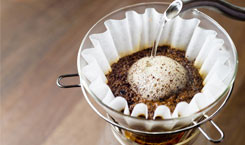Filter infusion
Everyone has it at home, the filter coffee maker. Which of course is completely out of date today. Is it? No! There is still excellent filter coffee. Whether by hand infusion or by the machine, it wakes you up and it goes fast!
In today's world of star barista and worldwide coffee specialities, the typical filter coffee, which is traditionally popular especially in Germany, is often dismissed as inferior "worker coke". That's a pity, because if you take a little time, you can prepare fabulous filter coffee with a little skill. And that without expensive machines.
The right coffee bean for filter infusion and its treatment
The best known is of course the normal filter coffee machine (we say "slurper", because the noises are unmistakable), which delivers coffee, not necessarily the worst, but also not the best. The contact time of the water with the coffee grounds is quite long and therefore also the extraction of undesirable substances, which promote bitter and sour flavours. Those who keep the coffee warm for hours after brewing can enjoy a "delicious" sour "Brat" coffee.
Slowly, modern coffee bars are also discovering filter coffee for themselves and more and more specialised brewing methods are coming onto the market.
But for a good filter coffee, you have to start with the base: the bean, as with every variation of the black gold. This is where error number one hides itself; many people buy ground coffee, plus coffee of inferior quality. Even if it is well packaged, it loses a large part of its aroma at the latest after the package has been opened for the first time. It is important to grind coffee just before brewing and to store the beans as cool and airtight as possible, because roasted coffee beans can also dry out.
The choice of bean is also important. Since the contact time between water and coffee grounds is much longer with pressureless brewing through a paper filter than with any espresso, many aromas and bitter substances are extracted from the bean, which otherwise remain hidden. Some coffee roasts are only really effective in this way, while others become almost inedible. A dark espresso roast in the filter machine is therefore usually not a good idea.
A bright, skilfully carried out long-term roasting forms the perfect basis for a good filter coffee. Since dark roasts sometimes contain too many bitter substances due to the increased roasting aromas, which are extracted too strongly due to the long contact time, lighter, milder roasts are better suited. However, the roasting duration plays a particularly important role. Coffee beans that are roasted gently but longer are particularly mild because the longer heat treatment breaks down or transforms many of the uncomfortable acids in advance.
The preparation of a good filter coffee
It is the way in which filter coffee is prepared that can make the difference.
The right water temperature is important regardless of the preparation method. With many filter coffee machines you have to rely on the correct setting of the machine. If you prepare your filter coffee by hand infusion, you should make sure that the water is neither boiling nor too cold. Too hot water can sometimes cause burnt, unpleasantly bitter aromas, while too cold water produces more watery coffee. If you do not want to use a thermometer, you can boil the water in a kettle and use it for brewing after about one minute of cooling.
The grinding degree should also be adapted to the desired result and the respective filter. The finer the coffee is ground, the shorter the contact time with the water should be. The water temperature should also be slightly lower, the finer the coffee grounds have a much larger surface area and aromas are extracted more quickly. If the water is hotter, then a somewhat coarser grinding is suitable. If too much coffee powder collects in the cup, the grinding degree was definitely too fine for the filter.
Especially with machines where the water temperature cannot be influenced, adjusting the grind and the amount of ground coffee can make a big difference in taste.
The Preparation Method Filter Infusion
In addition to the filter machine, the operation of which probably does not have to be explained here, preparation with a hand filter is becoming increasingly popular. After the right type of coffee and the right degree of grinding have been selected, about 10g per cup of coffee should be added to the filter. This corresponds to about one and a half tablespoons of ground coffee. With hot water, the coffee is slightly moistened in the filter and after half a minute, after it has swollen, the water is distributed evenly over the coffee. It is best to store the cooked filter coffee in an insulated thermo jug; leaving it on a heating plate can quickly spoil the aroma and give the coffee burnt aromas.
Espresso stronger than filter coffee?
Contrary to all stubborn half-truths, filter coffee contains considerably more caffeine than espresso, for example. Above all, because you rarely consume 250ml of espresso at once, filter coffee is usually the much better way to wake up. The popular combination "coffee and cigarette butts" makes little sense, by the way; nicotine accelerates the decomposition of caffeine.
Water Temperature
Ideally, the water temperature for brewing filter coffee should be between 90°C and 96°C. Water that is too hot can over-extract coffee oils and bitter substances, leading to a bitter taste. Conversely, water that is too cool may not extract enough flavor, resulting in a flat taste. If you let the water cool too much after boiling, it might cool down excessively. Try to let the water cool for only 30 seconds before pouring it over the coffee grounds.
There are also kettles specifically designed for pour-over brewing, called pour-over kettles or kettles. For example, Hario offers such kettles.
Coffee Quantity and Grind Size
Make sure that you use the correct ratio of coffee to water. A common ratio is 60 grams of coffee per liter of water. The grind size of the coffee also plays a crucial role. Too fine a grind can lead to over-extraction and bitterness, while too coarse a grind can result in under-extraction and a watery taste. Experiment with the grind size to find the one that best suits your taste.
Preheating the pot
It's good to preheat the pot, but if the coffee still ends up too cold, it may be because the pot is either preheated for too long or not enough. Try filling it with hot water and letting it sit for a few minutes before pouring it out and brewing the coffee.
Brewing Time
The duration that the water is in contact with the coffee grounds also affects the taste. A brewing time of 3-4 minutes is considered ideal for most filter coffee preparations. If you're using manual brewer, make sure to pour the water slowly and in circular motions to ensure even extraction.
Water Quality
The quality of water can make a significant difference. Hard water can result in a flat taste, while soft water can enhance flavors better. Whenever possible, use filtered water.
By adjusting these aspects, you can greatly enhance the taste of your coffee. It may require some experimentation to find the perfect balance for your taste, but that's part of the fun of making coffee. Good luck!

